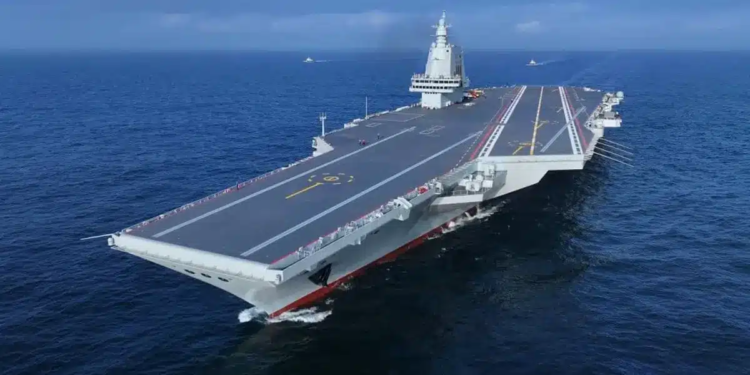President Xi Jinping inaugurated the Fujian, the first aircraft carrier of entirely Chinese design. A technological feat which marks a strategic turning point – but whose scope remains limited by its conventional propulsion.
A milestone for Beijing, a test for the sea
Under the watchful eye of Xi Jinping, the Chinese navy raised the flag of Fujianthe country’s third aircraft carrier and first equipped with electromagnetic catapults. The sailors vowed to “obey the Party and be able to win,” Xinhua reports, as state media celebrate “a historic milestone.”
For analysts, the symbol is strong: China is moving from the status of imitator to that of innovator. “It will be at least a year before it reaches full combat capability,” estimates Ben Lewis (PLATracker).
A “Chinese-style” electromagnetic revolution
Fujian introduced the Electromagnetic Catapult System (EMALS) for the first time, capable of launching heavy aircraft such as the stealth J-35 or the KJ-600 air alert more quickly and more flexibly.
This device, long reserved for the United States on Gerald R. Ford class aircraft carriers, now places China in the very exclusive club of powers mastering this technology.
Unlike the springboard ramps of Liaoning, Shandong, or the British Queen Elizabeth and Prince of Wales, electromagnetic catapults offer a horizontal takeoff, optimizing payload and takeoff rate.
The only downside: the tests still show aircraft taking off without armament, a sign of a preliminary test phase. In terms of tonnage and deck technologies, the Fujian is close to American standards – but remains far from their nuclear autonomy and their operational experience.
Diesel versus nuclear: the invisible limit
The Fujian remains powered by diesel, far from the endurance of the nuclear-powered American giants.
The Pentagon sees this as major progress, but believes that these ships “above all strengthen Chinese capacity in its periphery”.
“It is potentially a game changer for China, but there is still a lot to test”, nuance Collin Koh (RSIS, Singapore).
Between technological ambition and energy constraints, the Fujian embodies today’s China: self-confident, innovative, but still bound by its logistical limits.
Also read:
Trump restarts the atomic war: from the Westinghouse deal to nuclear tests








